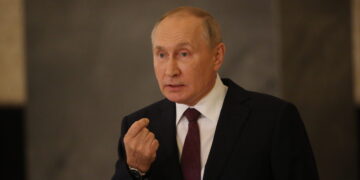When it was warmer than today…Then came the cooler Dark Ages… Followed by the Medieval Warm period, when it was at least as warm as today… Then we had the Little Ice Age — that drove the Vikings out of Greenland. And, most recently, a gradual 300-year warming to the present day.
That’s a lot of changes. And, of course, not one of them was caused by humans. During the past 400,000 years, there have been four major periods of glaciation — meaning that vast sheets of ice covered a good part of the globe — interrupted by brief interglacial periods.
We are in one of those periods right now. This is all part of the Pleistocene Ice Age which began in earnest two and a half million years ago. It’s still going on, which means that we are still living in an ice age. That’s the reason there’s so much ice at the poles.
Thirty million years ago the earth had no ice on it at all. So, then, what about carbon dioxide, the great villain of the Global Warming alarmists? Where does that fit in to this picture? Not as neatly as you might think. Temperatures and carbon dioxide levels do not show a strong correlation. In fact,
Over very long time spans — periods of hundreds of millions of years — they are often completely out of sync with each other. Over and over again, within virtually any time frame, we find the climate changing
— for reasons we do not fully understand. But we do know there are many more factors in play than simply the concentration of CO2 in the atmosphere — factors such as the shape and size of the earth’s elliptical orbit around the sun, activity from the sun, and the amount
Of wobble or tilt in the earth’s axis, among many others. Even the relatively short 300-year period from the peak of the Little Ice Age to the present has not been steady. The latest trend has been a warming one, but it began nearly a century before there were significant
Carbon dioxide emissions from burning fossil fuels. And, there has been no significant warming trend in the 21st century. Contrary to media headlines, the trend over the past couple of decades has been essentially flat. Meanwhile human-caused CO2 emissions are higher than ever. About 25 percent of all the CO2
Emissions from human sources have occurred during this period of no net warming. So, what are we in for next? Will the temperature resume an upward trend? Will it remain flat for a lengthy period? Or, will it begin to drop? No one knows. Not even the biggest, fastest computers.
All the information I’ve presented — the increases, decreases and plateaus in temperature over the ages and into the last centuries — is available to anyone who wants to seek it out. Yet to state these simple facts is to risk being called a “climate change denier.”
Not only is that absurd, it’s mean-spirited. It’s absurd because no one, not even the most fervent skeptic, denies that the climate is changing. And it’s mean-spirited because to call someone a climate change denier is to intentionally link them to people who deny the Holocaust. So, maybe it’s time to stop the name-calling.
Predicting the climate, one of the most complex systems on earth with thousands of inputs, many of which we don’t understand, isn’t an exact science, or anything close to it. Maybe it’s just a tad arrogant to suggest that we can predict the weather or the climate or just about anything 60 years from now.
The science is not “settled.” The debate is not over. The climate is always changing. It always has. And it always will. I’m Patrick Moore, Co-Founder of Greenpeace, for Prager University.

































 Reaction & Commentary
Reaction & Commentary











